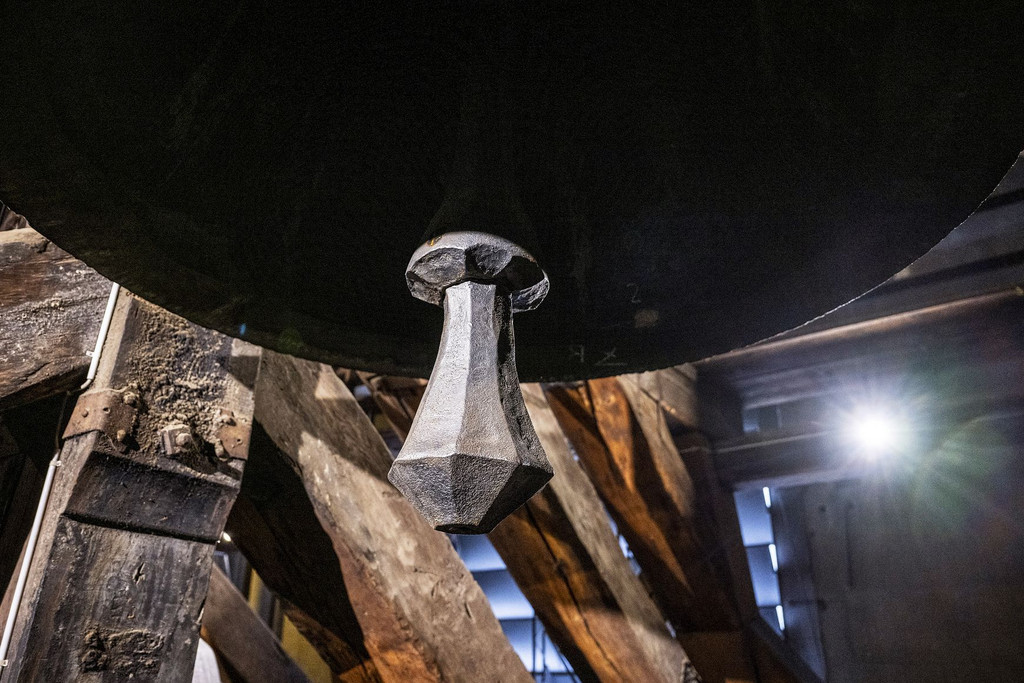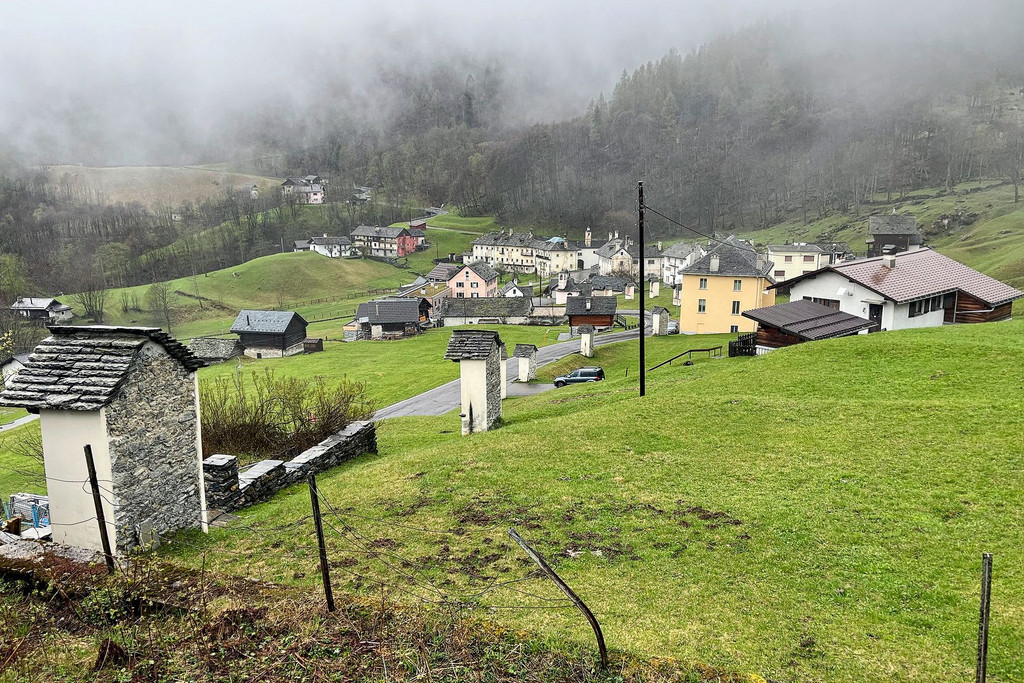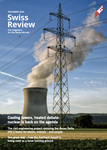I arrived in La Brévine on 2 July, amid blustery weather. The valley of the same name was cloaked in fog. As I got off the bus in the village square, I suddenly shivered. Was my summer attire – a t-shirt and a light raincoat – going to be enough? The digital thermometer hanging in the square was showing just 18 degrees Celsius. It was the La Brévine effect! Perched at just over 1,000 metres in altitude within a depression in the Jura mountains, this commune in the canton of Neuchâtel holds several records for its cold weather. Amongst them is the lowest temperature ever recorded by a MeteoSwiss local weather station: on 12 January 1987, the thermometer reached -41.8 degrees, setting the record for the coldest inhabited place in Switzerland. According to Jean-Maurice Gasser, the mayor of La Brévine: “It’s coldest first thing in the morning, when the sun is coming out. You would expect it to get warmer, but the sun’s rays clash with the cold from the ground.”
In the streets of this little village, crossed by four roads, a summertime stroller will find themselves sliding into a frosty fantasy. There is a shop which rents out cross-country skis on wheels during the summer, named Siberia Sports. A hostel, closed at the moment, bears the name Loup blanc (White wolf). Behind it is the Alaska furniture shop, and Isba, the Russian for a log hut, an old restaurant. But the village’s icy reputation has not always been so well celebrated: “its reputation made people think that the people were cold as well, whereas in fact, the cold doesn’t change anything. We just go about our business as usual,” comments Jean-Daniel Oppliger, manager of the restaurant and new hotel, the Hôtel-de-Ville. Oppliger participated in the launch of the Fête du froid (Cold festival), which first took place in 2012, in glacial winds.
Warmer winters and 30-degree summers
The teeth-chattering weather has been transformed into a marketing strategy. “We’ve had up to 5,000 visitors from Switzerland and France come to celebrate the cold,” enthuses the mayor who was in charge of the renovation and transformation of the Hôtel-de-Ville restaurant. This municipal property now offers accommodation for up to 27 tourists, as well as a large room at the back for hosting local events. La Brévine and its population of 630 are quite prosperous. “Finances are stable,” says Jean-Maurice Gasser. All the same, he would like to welcome some new people to the area, as it is “gradually growing smaller”.
At Siberia Sports, Pascal Schneider, who supplements his income by working as a carpenter during the summer, relies on the snow to keep his business running. He watches the winters go by in the knowledge that the years of snowfall perfect for snowshoeing and cross-country skiing belong to the past. “Last winter there was almost nothing. People were only able to go cross-country skiing three or four times. We could only use 30 kilometres of the 163 km track in the valley,” he remarks. Schneider grew up in the area and has seen the temperatures in Little Siberia change completely during his lifetime. “When I was younger, the temperatures would stay between -15 and -30 degrees for three weeks at a time. These days, we might see -25 degrees one morning and then rain two days later. In summer 2019, it was 30 degrees for two whole weeks,” he says. Another one for the record books: in 2006, temperatures in La Brévine reached 36 degrees.
Cold weather, warm hearts
Nevertheless, the summer nights remain chilly with the possibility of frost from mid-August onwards. In any case, tourists arrive in La Brévine with their own thermometer in mind. “People tell me it’s not all that cold,” says the manager of the sports shop. Even if it’s a few degrees warmer in winter now, higher up in the 20 km-long valley, the work of agricultural workers is still harder than elsewhere in Switzerland. In Cernil, at 1,200 metres in altitude, Kevin and Grégory Huguenin tell of their days spent out in the cold looking after their 100-strong cattle herd. Work begins at 5am, sometimes with a few strikes of a pickaxe to unfreeze the doors and a blowtorch to heat up the ends of the drinking pipes. “It’s a constant battle against the cold,” remarks Grégory, who remembers his first winter working in Cernil, with a thermometer showing -15 degrees and almost -30 degrees at the farm below, in Brouillet. Despite, or perhaps because of, this the two young brothers, who represent the seventh generation of Huguenins to live in the valley, love their region. The cold weather warms local hearts. “Around here, you can knock on anyone’s door and they’ll invite you in to eat,” says Kevin. “There aren’t a lot of people living in the valley, around 1,500 perhaps, but the people are there for each other,” adds his brother.
Crisp summer nights
In summer, the valley and its three villages, of which La Brévine is the only cold weather record holder, transform into a haven of sunny, crisp evenings. At two kilometres from the village, the Lac des Taillières is frozen in winter. But in summer, its murky waters see windsurfers and kitesurfers galore. The steppe-like high plateau offers countless scenic hiking paths, including notably a trail of border markers set out in 1819 touching the edge of neighbouring France. A historic walk incorporates 18 information panels, which provide an insight into this land of frost and snow. Geneviève Kohler, President of the society for local development, takes us to station number 13, a beautiful building and home to the parents of the Huguenin brothers. The lodge hides an old ferruginous spring, once known for its restorative qualities.
Another noteworthy body of water is the village stream. Known as “le Bied”, it disappears into a sinkhole, a sort of natural well, only to reappear in the Val-de-Travers. The part in La Brévine, set in the heart of the village, resembles something of a canyon. In 2018, the hole became clogged and overflowed, causing a flood. “People had 30 cm of water in their homes,” recalls the mayor of the commune. For the manager of the Hôtel-de-Ville, this is one of the factors explaining the Siberian climate of La Brévine. “In other mountain valleys in Neuchâtel, the water flows along the surface and carries the cold away with it,” explains Jean-Daniel Oppliger. “But here, le Bied disappears and the cold is left behind.” Could this be the real explanation? Perhaps, although the extreme temperatures of La Brévine could have a thousand explanations.
The secrets of the cold
In reality, the icy climate of La Brévine is caused by several factors. The main one is that the village is set in a closed off depression, where the cold stagnates, creating a metrological phenomenon called a “cold air lake”. For this phenomenon to occur, there needs to be high atmospheric pressure, a clear sky and an absence of wind and snow. In such situations, the neighbouring passes and mountaintops can show a difference of up to 30 degrees in temperature compared to the valley below. This is what was shown by a study completed in 2014 by the Institute of Geography at the University of Neuchâtel.




















Comments
Comments :
Continuez à nous faire visiter le pays, c'est très instructif
François Hainard « Le vent et le silence »:
Cette histoire est vraie et se passe a? la fin de la deuxie?me guerre mondiale à La Bre?vine, communauté protestante austère du Haut Jura neuchâtelois. Elle raconte l’amour impossible d’une fille de quinze ans avec un boulanger tessinois catholique de vingt-deux ans. Comment pourront-ils s’aimer dans des communautés rurales aux identités religieuses antagonistes, strictes et closes ? Ou? peuvent-ils aller quand la guerre se déroule a? deux kilomètres et que l’enfermement est complet ? Comment s’échapper?
Ein sehr interessanter Artikel ! Wenn Sie etwas in die Region eintauchen möchten : hier wäre eine Empfehlung eines Romans, der vor ein paar Tagen in der deutschen Übersetzung erschienen ist:
François Hainard, «Wind und Schweigen»
Dieser Roman erzählt eine wahre Begebenheit vom Ende des Zweiten Weltkrieges. Im kleinen Dorf La Bre?vine im rauen und sittenstrengen Neuenburger Jura verlieben sich die 15-jährige, einheimische Jeannette und der 22-jährige, zugezogene Tessiner Bäckergeselle Antonio. Doch ihre Liebe über die religiösen, kulturellen und sprachlichen Grenzen hinweg ist für seine katholischen Eltern ebenso undenkbar wie für ihre protestantische Familie. Als Jeannette schwanger wird, gerät das Paar in eine ausweglose Lage.
https://www.pearlbooksedition.ch/?page_id=2660
ne a lausanne en 1950, maintenant depuis 40 ans a miami.
mon coeur est toujours dans la foret et nos montagnes
chaque annee je rentre a pully.
enfants, nous parlions de la brevine...... t'as froid? encore heureux que tu n'habites pas la brevine... ahah!
encore un coin a visiter lors de mon prochain sejour
merci !
We John and Valerie Piguet always enjoy reading your Magazine! Thank you. Special me who came from BASEL near the FRENCH Boarder.
John born in RSA, JHB. Went to Uni in Le Brassue , Le Chenit VD for over 9 years. Long long ago. Proud to be Suisse. With best regards, Valerie Piguet
Bel article! Merci ! De m’avoir donner un moment de nostalgie !